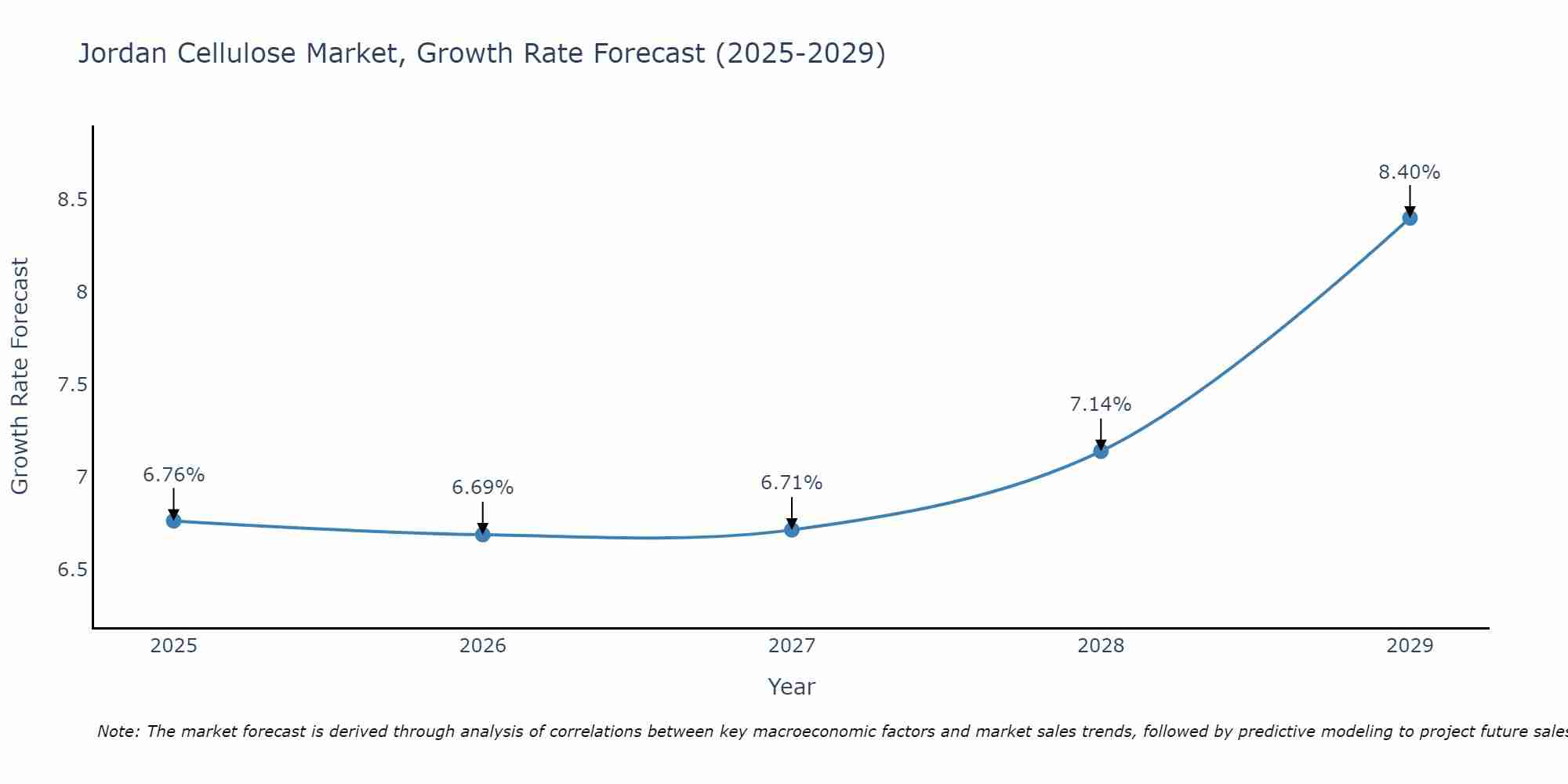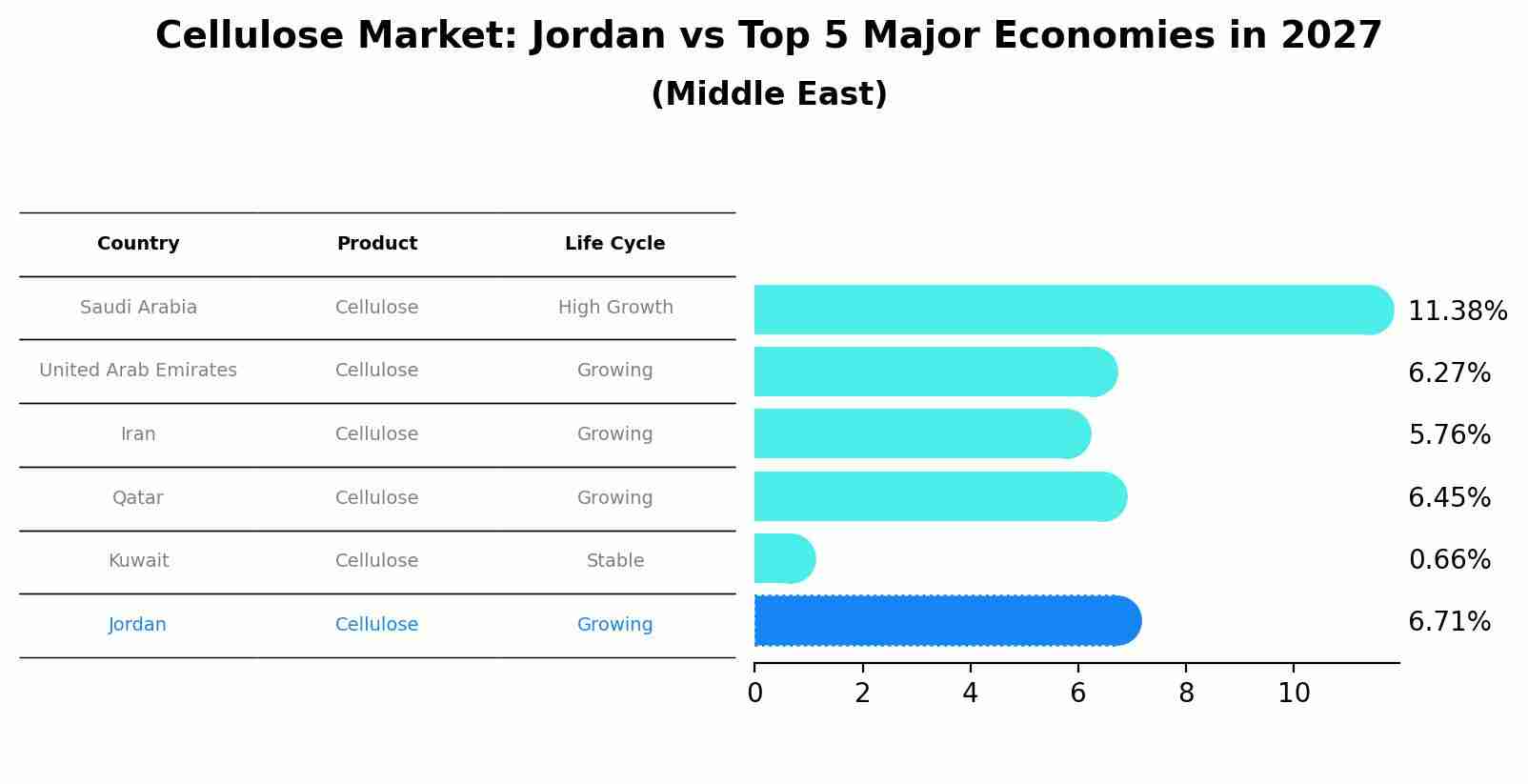Jordan Cellulose Market Outlook | Size, Growth, Forecast, Trends, Value, COVID-19 IMPACT, Analysis, Revenue, Share, Companies & Industry
| Product Code: ETC073985 | Publication Date: Jun 2021 | Updated Date: Apr 2025 | Product Type: Report | |
| Publisher: 6Wresearch | Author: Ravi Bhandari | No. of Pages: 70 | No. of Figures: 35 | No. of Tables: 5 |
Jordan Cellulose Market Size Growth Rate
The Jordan Cellulose Market is projected to witness mixed growth rate patterns during 2025 to 2029. From 6.76% in 2025, the growth rate steadily ascends to 8.40% in 2029.

Cellulose Market: Jordan vs Top 5 Major Economies in 2027 (Middle East)
The Cellulose market in Jordan is projected to grow at a growing growth rate of 6.71% by 2027, within the Middle East region led by Saudi Arabia, along with other countries like United Arab Emirates, Iran, Qatar and Kuwait, collectively shaping a dynamic and evolving market environment driven by innovation and increasing adoption of emerging technologies.

Jordan Cellulose Market Overview
The cellulose market in Jordan encompasses various cellulose derivatives and products, including cellulose esters, ethers, and fibers. Growing awareness about sustainable materials and increasing demand from end-use industries are driving market growth. Manufacturers are focusing on expanding their product portfolios and enhancing product quality to meet diverse market requirements.
Drivers of the market
The Jordan Cellulose market is driven by the diverse applications of cellulose derivatives in industries such as construction, textiles, pharmaceuticals, and food processing. Cellulose, derived from plant sources such as wood pulp and cotton, serves as a versatile raw material for manufacturing cellulose derivatives such as ethers, esters, and fibers. In Jordan, the demand for cellulose derivatives is propelled by the construction industry`s need for additives in cement, the textile industry`s requirement for sustainable fiber materials, and the pharmaceutical industry`s use of cellulose ethers in drug formulations. Moreover, increasing consumer awareness regarding eco-friendly and biodegradable products fosters market growth by driving demand for cellulose-based alternatives to synthetic materials. Additionally, investments in research and development initiatives aimed at enhancing cellulose derivative properties and applications further stimulate market expansion in Jordan.
Challenges of the market
The broader cellulose market in Jordan is impeded by issues such as the high cost and complexity of manufacturing processes. There is also a significant reliance on imported raw materials, which can be affected by international market conditions and trade policies. Additionally, stringent regulatory standards for environmental and safety compliance add to the operational challenges for producers in this market.
Government Policy of the market
The overall cellulose market in Jordan is influenced by government policies that support the broader industrial and environmental strategies of the country. The focus on sustainable development, coupled with industrial incentives, drives the growth of the cellulose market. Regulatory frameworks ensure that cellulose production meets environmental standards, promoting the use of renewable resources and innovative production techniques.
Key Highlights of the Report:
- Jordan Cellulose Market Outlook
- Market Size of Jordan Cellulose Market, 2024
- Forecast of Jordan Cellulose Market, 2031
- Historical Data and Forecast of Jordan Cellulose Revenues & Volume for the Period 2021-2031
- Jordan Cellulose Market Trend Evolution
- Jordan Cellulose Market Drivers and Challenges
- Jordan Cellulose Price Trends
- Jordan Cellulose Porter's Five Forces
- Jordan Cellulose Industry Life Cycle
- Historical Data and Forecast of Jordan Cellulose Market Revenues & Volume By Fiber Type for the Period 2021-2031
- Historical Data and Forecast of Jordan Cellulose Market Revenues & Volume By Natural Cellulose Fibers for the Period 2021-2031
- Historical Data and Forecast of Jordan Cellulose Market Revenues & Volume By Man-made Cellulose Fibers for the Period 2021-2031
- Historical Data and Forecast of Jordan Cellulose Market Revenues & Volume By Applications for the Period 2021-2031
- Historical Data and Forecast of Jordan Cellulose Market Revenues & Volume By Apparel for the Period 2021-2031
- Historical Data and Forecast of Jordan Cellulose Market Revenues & Volume By Home Textile for the Period 2021-2031
- Historical Data and Forecast of Jordan Cellulose Market Revenues & Volume By Industrial for the Period 2021-2031
- Historical Data and Forecast of Jordan Cellulose Market Revenues & Volume By Others for the Period 2021-2031
- Jordan Cellulose Import Export Trade Statistics
- Market Opportunity Assessment By Fiber Type
- Market Opportunity Assessment By Applications
- Jordan Cellulose Top Companies Market Share
- Jordan Cellulose Competitive Benchmarking By Technical and Operational Parameters
- Jordan Cellulose Company Profiles
- Jordan Cellulose Key Strategic Recommendations
Frequently Asked Questions About the Market Study (FAQs):
1 Executive Summary |
2 Introduction |
2.1 Key Highlights of the Report |
2.2 Report Description |
2.3 Market Scope & Segmentation |
2.4 Research Methodology |
2.5 Assumptions |
3 Jordan Cellulose Market Overview |
3.1 Jordan Country Macro Economic Indicators |
3.2 Jordan Cellulose Market Revenues & Volume, 2021 & 2031F |
3.3 Jordan Cellulose Market - Industry Life Cycle |
3.4 Jordan Cellulose Market - Porter's Five Forces |
3.5 Jordan Cellulose Market Revenues & Volume Share, By Fiber Type, 2021 & 2031F |
3.6 Jordan Cellulose Market Revenues & Volume Share, By Applications, 2021 & 2031F |
4 Jordan Cellulose Market Dynamics |
4.1 Impact Analysis |
4.2 Market Drivers |
4.3 Market Restraints |
5 Jordan Cellulose Market Trends |
6 Jordan Cellulose Market, By Types |
6.1 Jordan Cellulose Market, By Fiber Type |
6.1.1 Overview and Analysis |
6.1.2 Jordan Cellulose Market Revenues & Volume, By Fiber Type, 2021-2031F |
6.1.3 Jordan Cellulose Market Revenues & Volume, By Natural Cellulose Fibers, 2021-2031F |
6.1.4 Jordan Cellulose Market Revenues & Volume, By Man-made Cellulose Fibers, 2021-2031F |
6.2 Jordan Cellulose Market, By Applications |
6.2.1 Overview and Analysis |
6.2.2 Jordan Cellulose Market Revenues & Volume, By Apparel, 2021-2031F |
6.2.3 Jordan Cellulose Market Revenues & Volume, By Home Textile, 2021-2031F |
6.2.4 Jordan Cellulose Market Revenues & Volume, By Industrial, 2021-2031F |
6.2.5 Jordan Cellulose Market Revenues & Volume, By Others, 2021-2031F |
7 Jordan Cellulose Market Import-Export Trade Statistics |
7.1 Jordan Cellulose Market Export to Major Countries |
7.2 Jordan Cellulose Market Imports from Major Countries |
8 Jordan Cellulose Market Key Performance Indicators |
9 Jordan Cellulose Market - Opportunity Assessment |
9.1 Jordan Cellulose Market Opportunity Assessment, By Fiber Type, 2021 & 2031F |
9.2 Jordan Cellulose Market Opportunity Assessment, By Applications, 2021 & 2031F |
10 Jordan Cellulose Market - Competitive Landscape |
10.1 Jordan Cellulose Market Revenue Share, By Companies, 2024 |
10.2 Jordan Cellulose Market Competitive Benchmarking, By Operating and Technical Parameters |
11 Company Profiles |
12 Recommendations |
13 Disclaimer |
- Single User License$ 1,995
- Department License$ 2,400
- Site License$ 3,120
- Global License$ 3,795
Search
Thought Leadership and Analyst Meet
Our Clients
Related Reports
- Germany Breakfast Food Market (2026-2032) | Industry, Share, Growth, Size, Companies, Value, Analysis, Revenue, Trends, Forecast & Outlook
- Australia Briquette Market (2025-2031) | Growth, Size, Revenue, Forecast, Analysis, Trends, Value, Share, Industry & Companies
- Vietnam System Integrator Market (2025-2031) | Size, Companies, Analysis, Industry, Value, Forecast, Growth, Trends, Revenue & Share
- ASEAN and Thailand Brain Health Supplements Market (2025-2031) | Strategy, Consumer Insights, Analysis, Investment Trends, Opportunities, Growth, Size, Share, Industry, Revenue, Segments, Value, Segmentation, Supply, Forecast, Restraints, Outlook, Competition, Drivers, Trends, Demand, Pricing Analysis, Competitive, Strategic Insights, Companies, Challenges
- ASEAN Bearings Market (2025-2031) | Strategy, Consumer Insights, Analysis, Investment Trends, Opportunities, Growth, Size, Share, Industry, Revenue, Segments, Value, Segmentation, Supply, Forecast, Restraints, Outlook, Competition, Drivers, Trends, Demand, Pricing Analysis, Competitive, Strategic Insights, Companies, Challenges
- Europe Flooring Market (2025-2031) | Outlook, Share, Industry, Trends, Forecast, Companies, Revenue, Size, Analysis, Growth & Value
- Saudi Arabia Manlift Market (2025-2031) | Outlook, Size, Growth, Trends, Companies, Industry, Revenue, Value, Share, Forecast & Analysis
- Uganda Excavator, Crane, and Wheel Loaders Market (2025-2031) | Strategy, Consumer Insights, Analysis, Investment Trends, Opportunities, Growth, Size, Share, Industry, Revenue, Segments, Value, Segmentation, Supply, Forecast, Restraints, Outlook, Competition, Drivers, Trends, Demand, Pricing Analysis, Competitive, Strategic Insights, Companies, Challenges
- Rwanda Excavator, Crane, and Wheel Loaders Market (2025-2031) | Strategy, Consumer Insights, Analysis, Investment Trends, Opportunities, Growth, Size, Share, Industry, Revenue, Segments, Value, Segmentation, Supply, Forecast, Restraints, Outlook, Competition, Drivers, Trends, Demand, Pricing Analysis, Competitive, Strategic Insights, Companies, Challenges
- Kenya Excavator, Crane, and Wheel Loaders Market (2025-2031) | Strategy, Consumer Insights, Analysis, Investment Trends, Opportunities, Growth, Size, Share, Industry, Revenue, Segments, Value, Segmentation, Supply, Forecast, Restraints, Outlook, Competition, Drivers, Trends, Demand, Pricing Analysis, Competitive, Strategic Insights, Companies, Challenges
Industry Events and Analyst Meet
Whitepaper
- Middle East & Africa Commercial Security Market Click here to view more.
- Middle East & Africa Fire Safety Systems & Equipment Market Click here to view more.
- GCC Drone Market Click here to view more.
- Middle East Lighting Fixture Market Click here to view more.
- GCC Physical & Perimeter Security Market Click here to view more.
6WResearch In News
- Doha a strategic location for EV manufacturing hub: IPA Qatar
- Demand for luxury TVs surging in the GCC, says Samsung
- Empowering Growth: The Thriving Journey of Bangladesh’s Cable Industry
- Demand for luxury TVs surging in the GCC, says Samsung
- Video call with a traditional healer? Once unthinkable, it’s now common in South Africa
- Intelligent Buildings To Smooth GCC’s Path To Net Zero


















